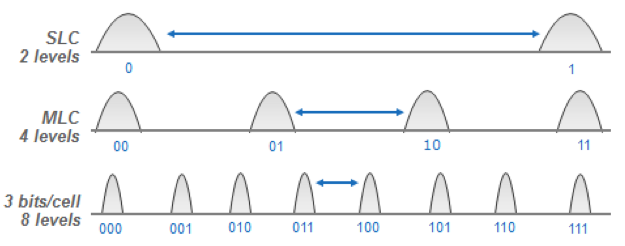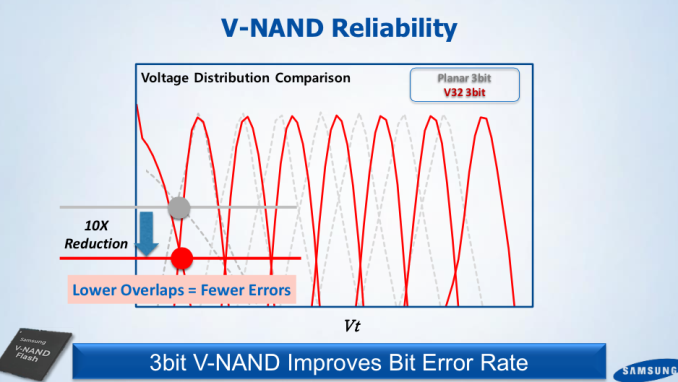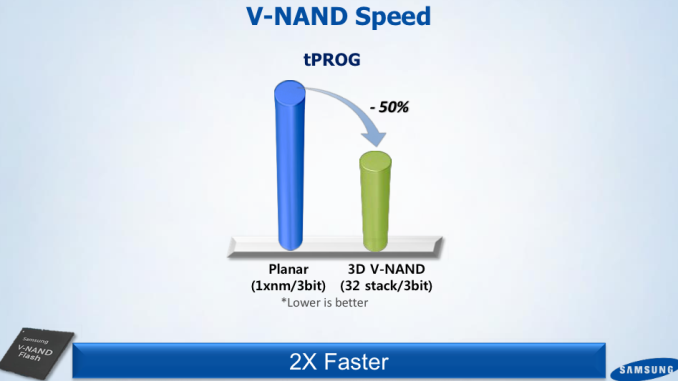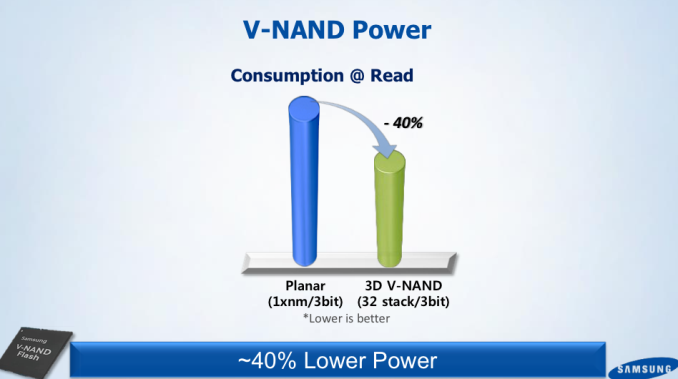Samsung SSD 850 EVO (120GB, 250GB, 500GB & 1TB) Review
by Kristian Vättö on December 8, 2014 10:00 AM ESTThree Bits and Three Dimensions: What's the Deal?
I've covered 3D NAND and TLC NAND in detail in the past and in this article I'll just explain what 3D technology means to TLC NAND and vice versa, so head over to the links above if you are in the search for a deeper analysis of the two technologies.
Truth to be told, 3D technology is ideal for TLC. The fundamental problem of TLC NAND has always been the limited endurance and performance, which is caused by the additional voltage states that are needed to store three bits (i.e. eight possible bit outputs) in one cell. With eight voltage states compared to four in MLC, TLC NAND is less resistant to wear out because it takes a smaller change in the cell charge to corrupt the cell value. Due to the way NAND works, the cells (or the insulators in the cell to be exact) wear out over time, which induces electron leakage that alters the cell charge and hence the voltage state. This gets worse with die shrinks because the number of electrons decreases, making the NAND even less tolerant to wear out.
The key aspect of 3D V-NAND is the process node. By going back to 40nm lithography, the number of electrons increase exponentially, which makes TLC a much more viable technology than it was with modern planar NAND. Obviously, V-NAND doesn't change the basics of TLC NAND because it still takes eight voltage states to differentiate all the possible 3-bit outputs, but thanks to the increased number of electrons there is more breathing room between the states and thus the cells are more error tolerant.
Samsung claims 10x reduction in voltage state overlaps, which is a massive change for the better. You can see how crammed the planar TLC voltage states are, so it's no wonder that the endurance is low because the states are practically overlapping at each point in the voltage distribution and hence even tiny changes in the cell voltage can alter the cell's voltage state.
The larger cell structure also enables higher performance because it takes less iterations to program a cell. With planar TLC NAND it took multiple very high voltage pulses as well as numerous verification process to reach the right charge, but with looser voltage distribution the programming process has less steps and thus takes less time.
And given the lower read/program latencies and less need for error correction, the power consumption is also considerably lower.
In addition to better latency and power consumption characteristics, Samsung claims doubled the density over its 19nm planar TLC NAND, but without knowing the die size of 128Gbit 32-layer TLC V-NAND, it's hard to say how accurate this is. There have been some whispering that the 128Gbit die would actually be identical to the 86Gbit MLC die because 86Gbit multiplied by 1.5 equals 129Gbit and at the silicon level MLC and TLC aren't any different, but for now that's just speculation.
What I do know is that Samsung started the mass production of TLC V-NAND later, which suggests that the two aren't completely uniform. Moreover, from what I know TLC NAND requires some changes to the peripheral circuitry in order to read three bits from one cell, so while the NAND memory arrays could be alike the die size is still likely at least slightly different. Anyway, we'll find out when Chipworks (or some other silicon analysis company) takes a closer look at the NAND die itself.















97 Comments
View All Comments
TEAMSWITCHER - Monday, December 8, 2014 - link
I'm in complete agreement. I'm not going to buy another 2.5" SSD before I can get an 850 Pro (512 GB) equivalent with an M.2 interface. I have two motherboards with empty M.2 slots waiting for the market to catch up. I know about the XP941, but the pricing isn't great. M.2 drives should cost almost the same as a 2.5" drive...especially after eliminating the worthless metal/plastic box.extide - Monday, December 8, 2014 - link
Seems to me like TLC will become the standard mainstream for 3D/VNAND, where as MLC will be pretty much only for high end/enterprise, somewhat like SLC was back in the day.MadDuffy - Monday, December 8, 2014 - link
Newegg prices (USD) are up:120 GB - 90
250 GB - 140
500 GB - 250
1 TB - 470
Email I received indicates these are promotional prices available through Dec 14th
casperes1996 - Monday, December 8, 2014 - link
Last page, fifth paragraph, last line:"If I was"
Should be: "If I were"
I know I'm a cunt for pointing it out, but I only do so because I generally think Anandtech offers fairly decently written articles, and I care too much about this sort of piss...
Sorry.
apudapus - Monday, December 8, 2014 - link
How is data retention with this type of TLC NAND? Can the drive be powered off for a week or a month before data gets corrupted? While the drive is powered on, I assume there are refresh features for stale (a.k.a. infrequently accessed) data.hojnikb - Monday, December 8, 2014 - link
If its up to jedec (i imagine it is) then its good for atleast a year.kgh00007 - Monday, December 8, 2014 - link
But in reality what are they going to be like? I don't think I'll buy another Samsung TLC drive after owning the 120 GB 840 EVO for the last while! It performs erratically, especially when resuming from hibernate. It can take anywhere from 10 secs to boot, up to 5 minutes, and I have applied the latest firmware and run the speed recovery app from Samsung. I have an mSata Crucial m500 240GB which is slower on paper, but in reality is much quicker and the performance is 100% consistent, it does the same thing, every time at the same speed!!MLC all the way for me without any turbowrite nonsense, just straight forward advertised speeds across the whole drive all the time, without loosing data due to poor charge retention along the way!
Lolimaster - Monday, December 8, 2014 - link
Your EVO is 120 and your other drive is 240, less nand, more erratic, simple. Look at the chart, you get consistent writes/read with 500-1TB models.kgh00007 - Saturday, December 13, 2014 - link
Less nand equals slower performance, not more erratic performance. But it should perform at it's given speed consistentantly. I have over 30% of the drive free and 10% set as over provisioning on the 840 EVO. There is no excuse for a 5 minute boot time with an SSD. I don't trust these Samsung drives after my experience!mlkmade - Monday, December 8, 2014 - link
So I'm confused as its not very clear...Is Turbowrite turned on for all your benchmarks?Is turbowrite needed to hit the the 540/520 read/write times? I saw the chart with TurboWrite on and off. So with turbowrite off this drive only gets 100mb/s ?
This article is very vague in regards to that.